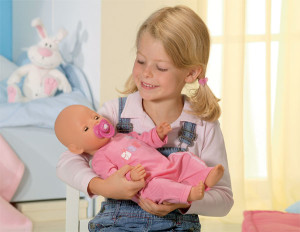Structured Doll Play for Dental Anxiety
What is Structured Doll Play for Dental Anxiety?
 Structured doll play is a fun and animated way of story telling for parents to help children who are feeling anxious about going to visit the dentist. It provides a brief and precise experience for children, preparing them for a dental visit that may be anxiety provoking. It has a specific purpose and sends a clear message. (You will be safe at the dentist office). It’s important that the message fit what the parent believes is most concerning to the child). Your goal is to help your child feel more comfortable about going to the dentist office.
Structured doll play is a fun and animated way of story telling for parents to help children who are feeling anxious about going to visit the dentist. It provides a brief and precise experience for children, preparing them for a dental visit that may be anxiety provoking. It has a specific purpose and sends a clear message. (You will be safe at the dentist office). It’s important that the message fit what the parent believes is most concerning to the child). Your goal is to help your child feel more comfortable about going to the dentist office.
An Important Note: If you are anxious about taking your child to the dentist, your child will pick up on your anxiety. You might consider having the most relaxed parent taking the child to the first appointment. Do not make any statements around your child such as, “I hate going to the dentist” or make statements that may not be true; such as, “You are going to have
Can my child benefit from structured doll play?
If your child is showing anxiety or fear about going for a dental exam, he/she can probably benefit.
What age does structured doll play benefit?
Structured doll play works best with children from ages 2 – 6, yet may be adapted for older children
1. INSTRUCTIONS FOR STRUCTURED DOLL PLAY
You create a story about the upcoming real trip to the dental office instead of reading out of storybook. Your purpose is to help Jake feel more comfortable about going to the dentist.
a. The story will involve real characters such as Mom, Dad, Jake (your child), dental hygienist, dentist, etc.
b. The story covers the time just before going for your child’s appointment, the actual trip to the dentist
c. Use dolls to enhance the dramatic effect and help your child remember. You can also use sound effects and basic procedures (Walking in the office, someone calling for the child, walking back to the dentist’s office with mom, dad, or whomever is with the child, the dentist working on the child’s teeth, coming back out to the waiting room, checking out, and then going to do something the child enjoys.
Predictability = security.
The purpose is to enrich the story and make it more powerful and fun. Remember, young children understand concrete things like dolls and scenes better than promises and reasons.
2. THE MAKING OF THE STORY
Ask your child to choose stuffed animals , dolls, or puppets to represent all people that will be in the story. (Mom, Dad, Jake, Dental Hygienist, Receptionist, Dentist). Hold the characters and in an animated fashion, have them talk and move. A story includes a beginning, middle, and an end. Start with an introductory sentence. (E.g.: This is a story about Jake going to the dentist office). Introduce the characters by using real names of people. Then begin the actual story by giving a background for the story (e.g.: a predictable routine, like waking up in the morning).
Tell the story. (Don’t use ‘you’ to refer to the doll representing your child. Use your child’s name. (E.g.: Jake is saying hi to Dr. Brown,” rather than “You are saying hi to Dr. Brown”.) Give content to the story by putting in details (e.g.: putting on shoes, buckling seat belt, walking into the office. Remember to exaggerate, use sound effects (You’ll probably feel silly at first, but children love it!)
Remember to end the story on a positive note. Don’t leave your child hanging.
Example: “Mom drives back to Jake’s house. The garage door goes up. (Make an animated sound. Drrrrrup!) Jake
opens the door and runs in the house. The family dog runs to Jake. Jake laughs and hugs the dog. Mom fixes Jake his
3. THINGS TO REMEMBER
This is a creative story. You will need to decide on a comfortable time and place to do structured doll play and prepare your props (dolls) ahead of time. A good time might be in your child’s bedroom in the evening before bedtime (To avoid disruptions and create a routine). You don’t need to buy any special dolls-use your child’s dolls and stuffed animals or puppets.
(Save your money to give yourself a treat after telling a good story—it’s a lot of work to tell a really good story!)
Retell the story once each day leading up to your child’s appointment. A good time to start is 10-14 days before the dental appointment. On the day of the dental appointment, let your child know that you will actually be performing the story for real. Be positive! Try to stick to the story as much as possible, including your child in the dialogue and saying things such as, “Now what happens next?”
Adapted from: Child Parent Relationship Therapy (CPRT). Bratton, S., Landreth, G., Kellam, T., & Blackard, S.
Courtesy of: Crossroads Child & Family Counseling, PLLC
